International Marketing Report: Analyzing Organic Food Market in India
VerifiedAdded on 2023/02/01
|10
|2549
|51
Report
AI Summary
This report provides a comprehensive analysis of the international marketing aspects of the organic food industry, with a specific focus on the Indian market. The report begins with an overview of the PESTLE analysis, examining the political, economic, social, technological, legal, and environmental factors influencing the organic food sector. It delves into the impact of government policies, economic stability, changing consumer behavior, technological advancements, and legal regulations. The report further analyzes the organic food industry in India using a SWOT analysis, highlighting the strengths, weaknesses, opportunities, and threats. The strengths include the safety and nutritional benefits of organic foods, while weaknesses include premium pricing and lack of farmer awareness. Opportunities include the rising middle class and increasing health awareness, while threats include GMOs and cheap substitutes. Finally, the report examines the competitive landscape, identifying key players and their market strategies, providing insights into the challenges and prospects of the organic food market in India.
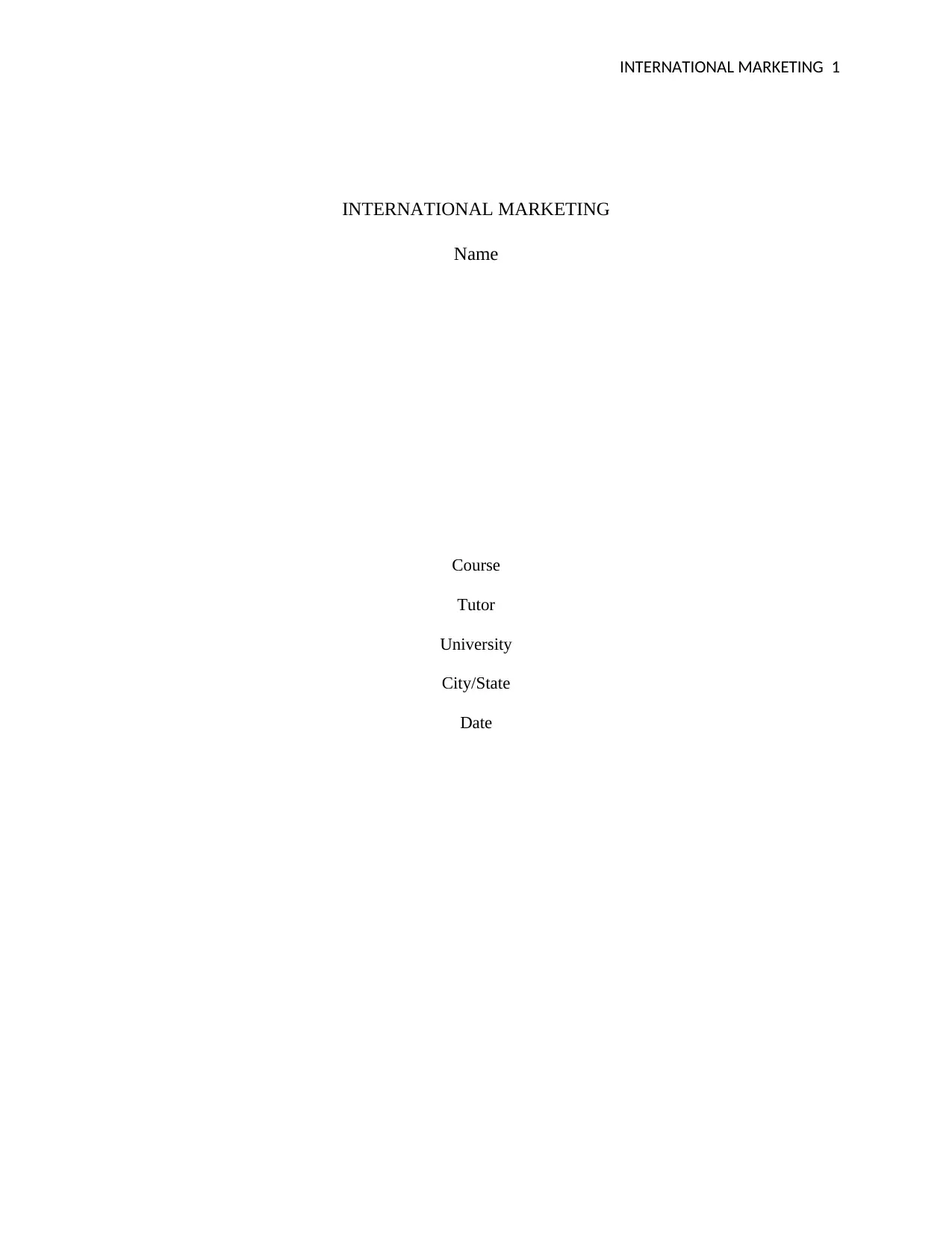
INTERNATIONAL MARKETING 1
INTERNATIONAL MARKETING
Name
Course
Tutor
University
City/State
Date
INTERNATIONAL MARKETING
Name
Course
Tutor
University
City/State
Date
Paraphrase This Document
Need a fresh take? Get an instant paraphrase of this document with our AI Paraphraser
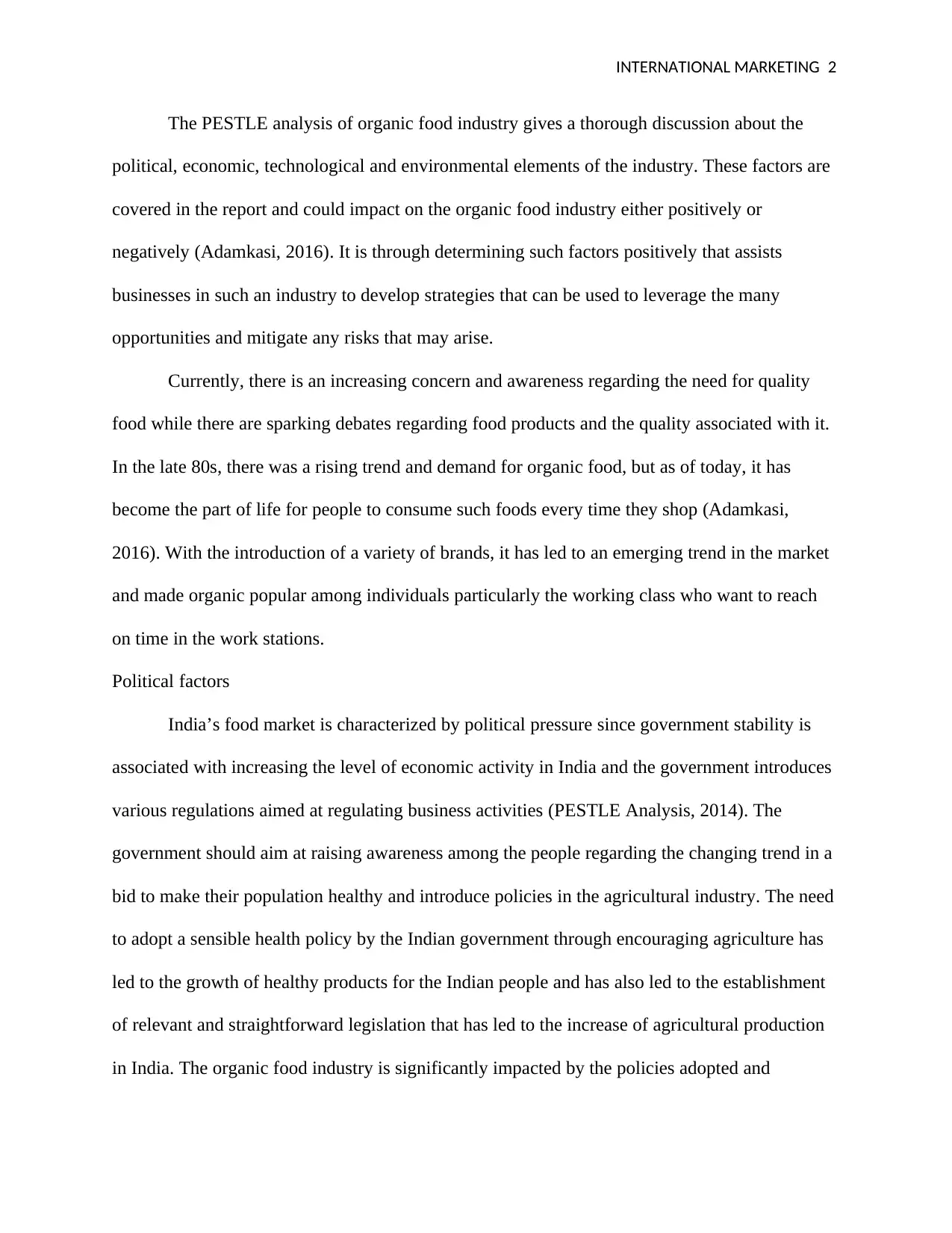
INTERNATIONAL MARKETING 2
The PESTLE analysis of organic food industry gives a thorough discussion about the
political, economic, technological and environmental elements of the industry. These factors are
covered in the report and could impact on the organic food industry either positively or
negatively (Adamkasi, 2016). It is through determining such factors positively that assists
businesses in such an industry to develop strategies that can be used to leverage the many
opportunities and mitigate any risks that may arise.
Currently, there is an increasing concern and awareness regarding the need for quality
food while there are sparking debates regarding food products and the quality associated with it.
In the late 80s, there was a rising trend and demand for organic food, but as of today, it has
become the part of life for people to consume such foods every time they shop (Adamkasi,
2016). With the introduction of a variety of brands, it has led to an emerging trend in the market
and made organic popular among individuals particularly the working class who want to reach
on time in the work stations.
Political factors
India’s food market is characterized by political pressure since government stability is
associated with increasing the level of economic activity in India and the government introduces
various regulations aimed at regulating business activities (PESTLE Analysis, 2014). The
government should aim at raising awareness among the people regarding the changing trend in a
bid to make their population healthy and introduce policies in the agricultural industry. The need
to adopt a sensible health policy by the Indian government through encouraging agriculture has
led to the growth of healthy products for the Indian people and has also led to the establishment
of relevant and straightforward legislation that has led to the increase of agricultural production
in India. The organic food industry is significantly impacted by the policies adopted and
The PESTLE analysis of organic food industry gives a thorough discussion about the
political, economic, technological and environmental elements of the industry. These factors are
covered in the report and could impact on the organic food industry either positively or
negatively (Adamkasi, 2016). It is through determining such factors positively that assists
businesses in such an industry to develop strategies that can be used to leverage the many
opportunities and mitigate any risks that may arise.
Currently, there is an increasing concern and awareness regarding the need for quality
food while there are sparking debates regarding food products and the quality associated with it.
In the late 80s, there was a rising trend and demand for organic food, but as of today, it has
become the part of life for people to consume such foods every time they shop (Adamkasi,
2016). With the introduction of a variety of brands, it has led to an emerging trend in the market
and made organic popular among individuals particularly the working class who want to reach
on time in the work stations.
Political factors
India’s food market is characterized by political pressure since government stability is
associated with increasing the level of economic activity in India and the government introduces
various regulations aimed at regulating business activities (PESTLE Analysis, 2014). The
government should aim at raising awareness among the people regarding the changing trend in a
bid to make their population healthy and introduce policies in the agricultural industry. The need
to adopt a sensible health policy by the Indian government through encouraging agriculture has
led to the growth of healthy products for the Indian people and has also led to the establishment
of relevant and straightforward legislation that has led to the increase of agricultural production
in India. The organic food industry is significantly impacted by the policies adopted and
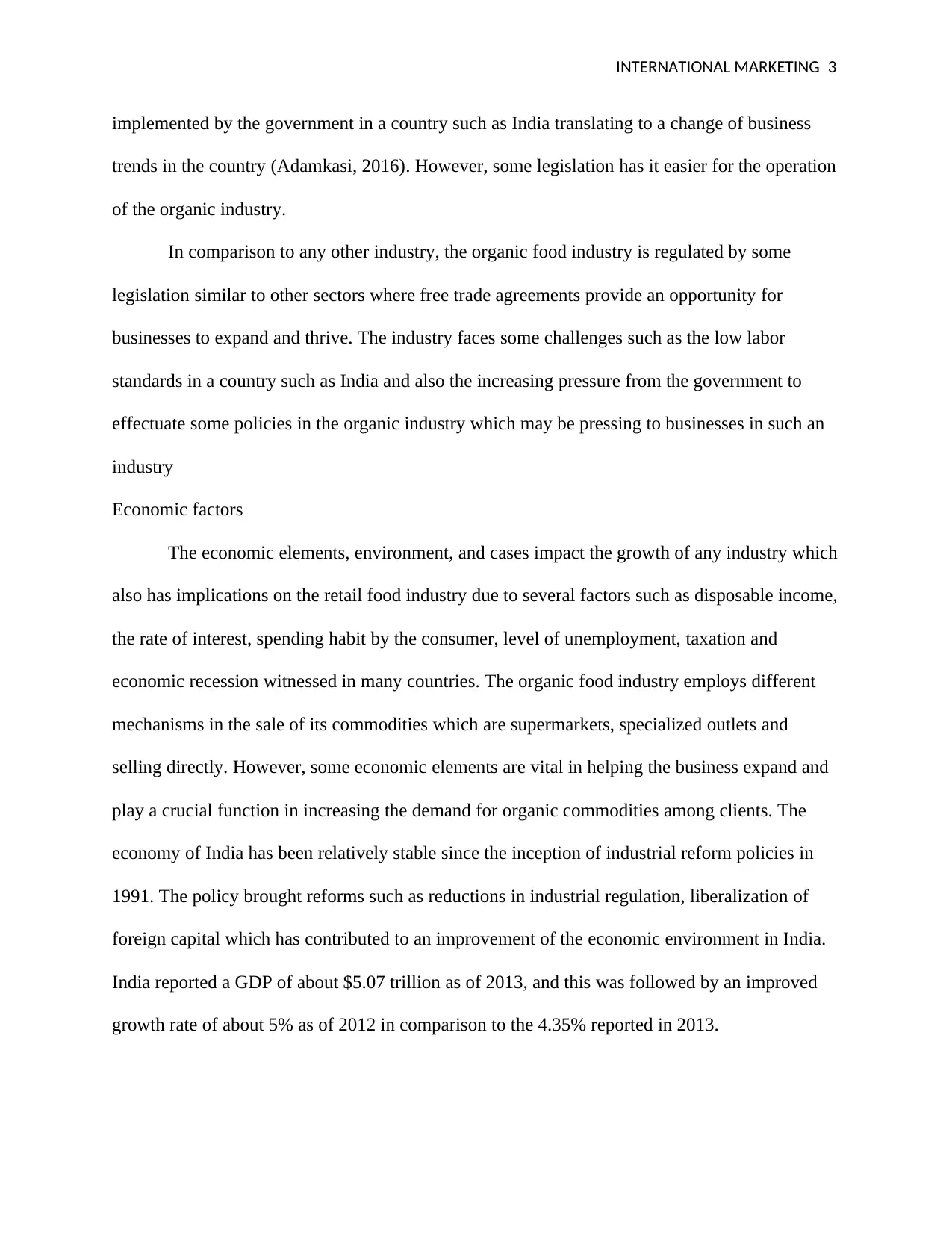
INTERNATIONAL MARKETING 3
implemented by the government in a country such as India translating to a change of business
trends in the country (Adamkasi, 2016). However, some legislation has it easier for the operation
of the organic industry.
In comparison to any other industry, the organic food industry is regulated by some
legislation similar to other sectors where free trade agreements provide an opportunity for
businesses to expand and thrive. The industry faces some challenges such as the low labor
standards in a country such as India and also the increasing pressure from the government to
effectuate some policies in the organic industry which may be pressing to businesses in such an
industry
Economic factors
The economic elements, environment, and cases impact the growth of any industry which
also has implications on the retail food industry due to several factors such as disposable income,
the rate of interest, spending habit by the consumer, level of unemployment, taxation and
economic recession witnessed in many countries. The organic food industry employs different
mechanisms in the sale of its commodities which are supermarkets, specialized outlets and
selling directly. However, some economic elements are vital in helping the business expand and
play a crucial function in increasing the demand for organic commodities among clients. The
economy of India has been relatively stable since the inception of industrial reform policies in
1991. The policy brought reforms such as reductions in industrial regulation, liberalization of
foreign capital which has contributed to an improvement of the economic environment in India.
India reported a GDP of about $5.07 trillion as of 2013, and this was followed by an improved
growth rate of about 5% as of 2012 in comparison to the 4.35% reported in 2013.
implemented by the government in a country such as India translating to a change of business
trends in the country (Adamkasi, 2016). However, some legislation has it easier for the operation
of the organic industry.
In comparison to any other industry, the organic food industry is regulated by some
legislation similar to other sectors where free trade agreements provide an opportunity for
businesses to expand and thrive. The industry faces some challenges such as the low labor
standards in a country such as India and also the increasing pressure from the government to
effectuate some policies in the organic industry which may be pressing to businesses in such an
industry
Economic factors
The economic elements, environment, and cases impact the growth of any industry which
also has implications on the retail food industry due to several factors such as disposable income,
the rate of interest, spending habit by the consumer, level of unemployment, taxation and
economic recession witnessed in many countries. The organic food industry employs different
mechanisms in the sale of its commodities which are supermarkets, specialized outlets and
selling directly. However, some economic elements are vital in helping the business expand and
play a crucial function in increasing the demand for organic commodities among clients. The
economy of India has been relatively stable since the inception of industrial reform policies in
1991. The policy brought reforms such as reductions in industrial regulation, liberalization of
foreign capital which has contributed to an improvement of the economic environment in India.
India reported a GDP of about $5.07 trillion as of 2013, and this was followed by an improved
growth rate of about 5% as of 2012 in comparison to the 4.35% reported in 2013.
⊘ This is a preview!⊘
Do you want full access?
Subscribe today to unlock all pages.

Trusted by 1+ million students worldwide
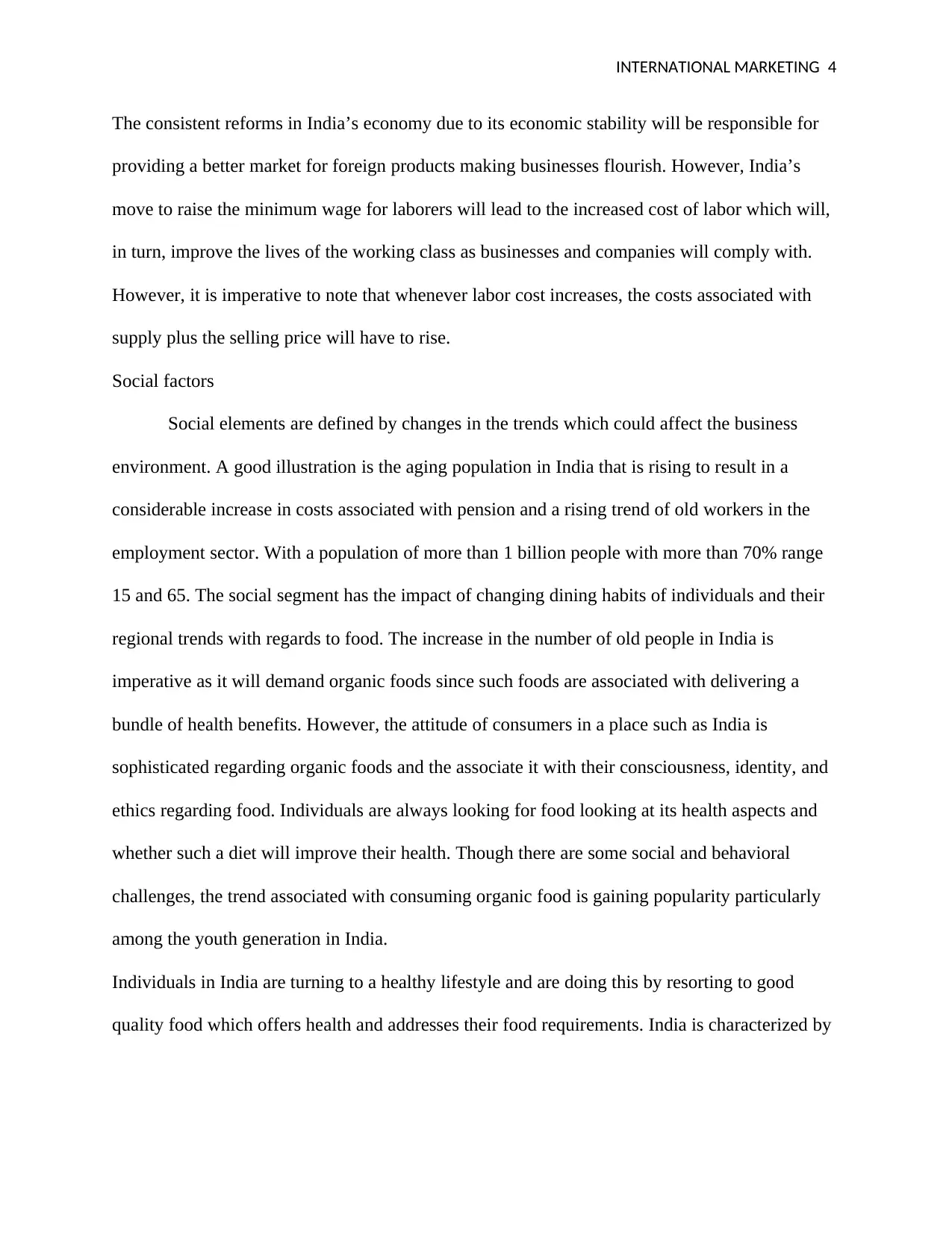
INTERNATIONAL MARKETING 4
The consistent reforms in India’s economy due to its economic stability will be responsible for
providing a better market for foreign products making businesses flourish. However, India’s
move to raise the minimum wage for laborers will lead to the increased cost of labor which will,
in turn, improve the lives of the working class as businesses and companies will comply with.
However, it is imperative to note that whenever labor cost increases, the costs associated with
supply plus the selling price will have to rise.
Social factors
Social elements are defined by changes in the trends which could affect the business
environment. A good illustration is the aging population in India that is rising to result in a
considerable increase in costs associated with pension and a rising trend of old workers in the
employment sector. With a population of more than 1 billion people with more than 70% range
15 and 65. The social segment has the impact of changing dining habits of individuals and their
regional trends with regards to food. The increase in the number of old people in India is
imperative as it will demand organic foods since such foods are associated with delivering a
bundle of health benefits. However, the attitude of consumers in a place such as India is
sophisticated regarding organic foods and the associate it with their consciousness, identity, and
ethics regarding food. Individuals are always looking for food looking at its health aspects and
whether such a diet will improve their health. Though there are some social and behavioral
challenges, the trend associated with consuming organic food is gaining popularity particularly
among the youth generation in India.
Individuals in India are turning to a healthy lifestyle and are doing this by resorting to good
quality food which offers health and addresses their food requirements. India is characterized by
The consistent reforms in India’s economy due to its economic stability will be responsible for
providing a better market for foreign products making businesses flourish. However, India’s
move to raise the minimum wage for laborers will lead to the increased cost of labor which will,
in turn, improve the lives of the working class as businesses and companies will comply with.
However, it is imperative to note that whenever labor cost increases, the costs associated with
supply plus the selling price will have to rise.
Social factors
Social elements are defined by changes in the trends which could affect the business
environment. A good illustration is the aging population in India that is rising to result in a
considerable increase in costs associated with pension and a rising trend of old workers in the
employment sector. With a population of more than 1 billion people with more than 70% range
15 and 65. The social segment has the impact of changing dining habits of individuals and their
regional trends with regards to food. The increase in the number of old people in India is
imperative as it will demand organic foods since such foods are associated with delivering a
bundle of health benefits. However, the attitude of consumers in a place such as India is
sophisticated regarding organic foods and the associate it with their consciousness, identity, and
ethics regarding food. Individuals are always looking for food looking at its health aspects and
whether such a diet will improve their health. Though there are some social and behavioral
challenges, the trend associated with consuming organic food is gaining popularity particularly
among the youth generation in India.
Individuals in India are turning to a healthy lifestyle and are doing this by resorting to good
quality food which offers health and addresses their food requirements. India is characterized by
Paraphrase This Document
Need a fresh take? Get an instant paraphrase of this document with our AI Paraphraser
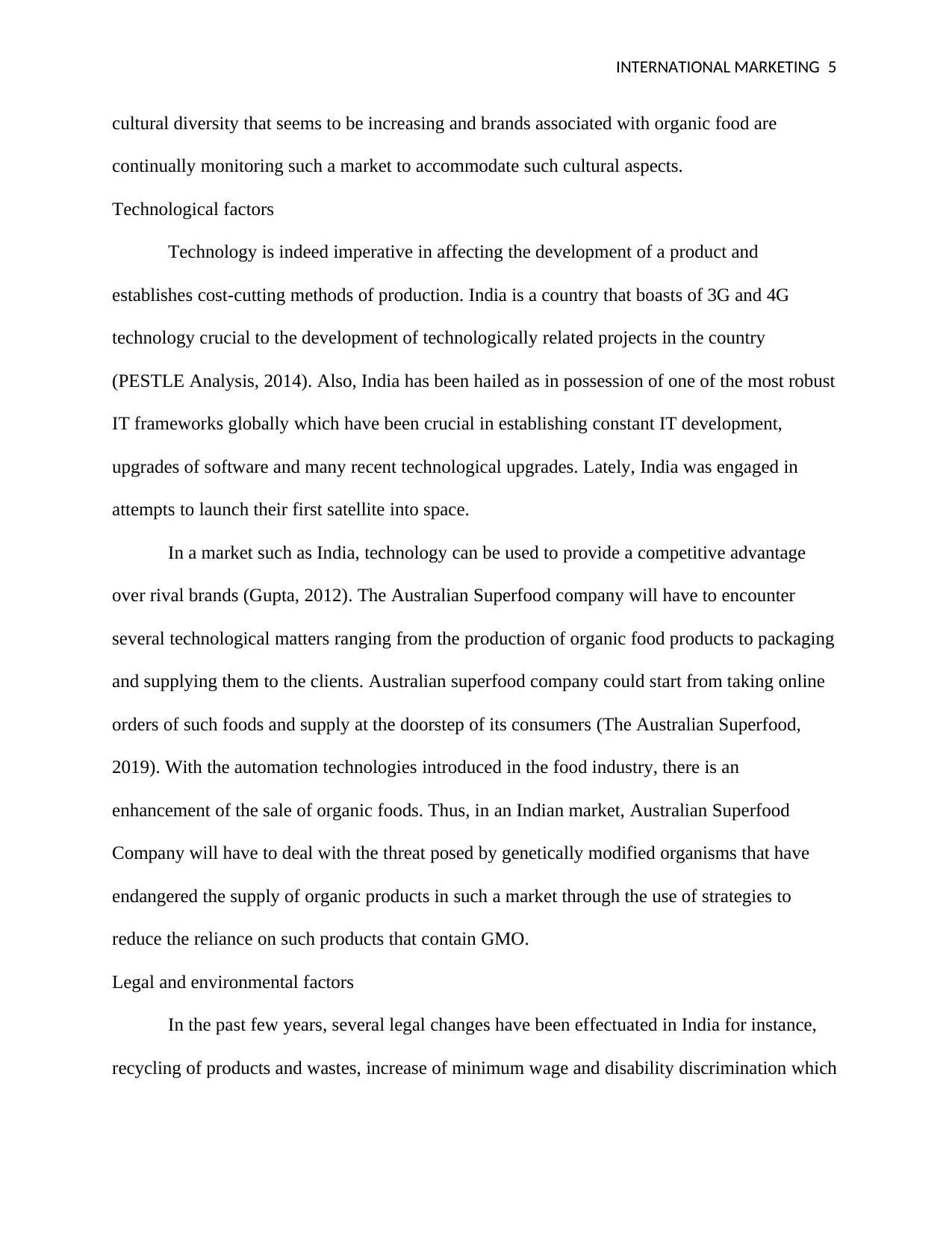
INTERNATIONAL MARKETING 5
cultural diversity that seems to be increasing and brands associated with organic food are
continually monitoring such a market to accommodate such cultural aspects.
Technological factors
Technology is indeed imperative in affecting the development of a product and
establishes cost-cutting methods of production. India is a country that boasts of 3G and 4G
technology crucial to the development of technologically related projects in the country
(PESTLE Analysis, 2014). Also, India has been hailed as in possession of one of the most robust
IT frameworks globally which have been crucial in establishing constant IT development,
upgrades of software and many recent technological upgrades. Lately, India was engaged in
attempts to launch their first satellite into space.
In a market such as India, technology can be used to provide a competitive advantage
over rival brands (Gupta, 2012). The Australian Superfood company will have to encounter
several technological matters ranging from the production of organic food products to packaging
and supplying them to the clients. Australian superfood company could start from taking online
orders of such foods and supply at the doorstep of its consumers (The Australian Superfood,
2019). With the automation technologies introduced in the food industry, there is an
enhancement of the sale of organic foods. Thus, in an Indian market, Australian Superfood
Company will have to deal with the threat posed by genetically modified organisms that have
endangered the supply of organic products in such a market through the use of strategies to
reduce the reliance on such products that contain GMO.
Legal and environmental factors
In the past few years, several legal changes have been effectuated in India for instance,
recycling of products and wastes, increase of minimum wage and disability discrimination which
cultural diversity that seems to be increasing and brands associated with organic food are
continually monitoring such a market to accommodate such cultural aspects.
Technological factors
Technology is indeed imperative in affecting the development of a product and
establishes cost-cutting methods of production. India is a country that boasts of 3G and 4G
technology crucial to the development of technologically related projects in the country
(PESTLE Analysis, 2014). Also, India has been hailed as in possession of one of the most robust
IT frameworks globally which have been crucial in establishing constant IT development,
upgrades of software and many recent technological upgrades. Lately, India was engaged in
attempts to launch their first satellite into space.
In a market such as India, technology can be used to provide a competitive advantage
over rival brands (Gupta, 2012). The Australian Superfood company will have to encounter
several technological matters ranging from the production of organic food products to packaging
and supplying them to the clients. Australian superfood company could start from taking online
orders of such foods and supply at the doorstep of its consumers (The Australian Superfood,
2019). With the automation technologies introduced in the food industry, there is an
enhancement of the sale of organic foods. Thus, in an Indian market, Australian Superfood
Company will have to deal with the threat posed by genetically modified organisms that have
endangered the supply of organic products in such a market through the use of strategies to
reduce the reliance on such products that contain GMO.
Legal and environmental factors
In the past few years, several legal changes have been effectuated in India for instance,
recycling of products and wastes, increase of minimum wage and disability discrimination which
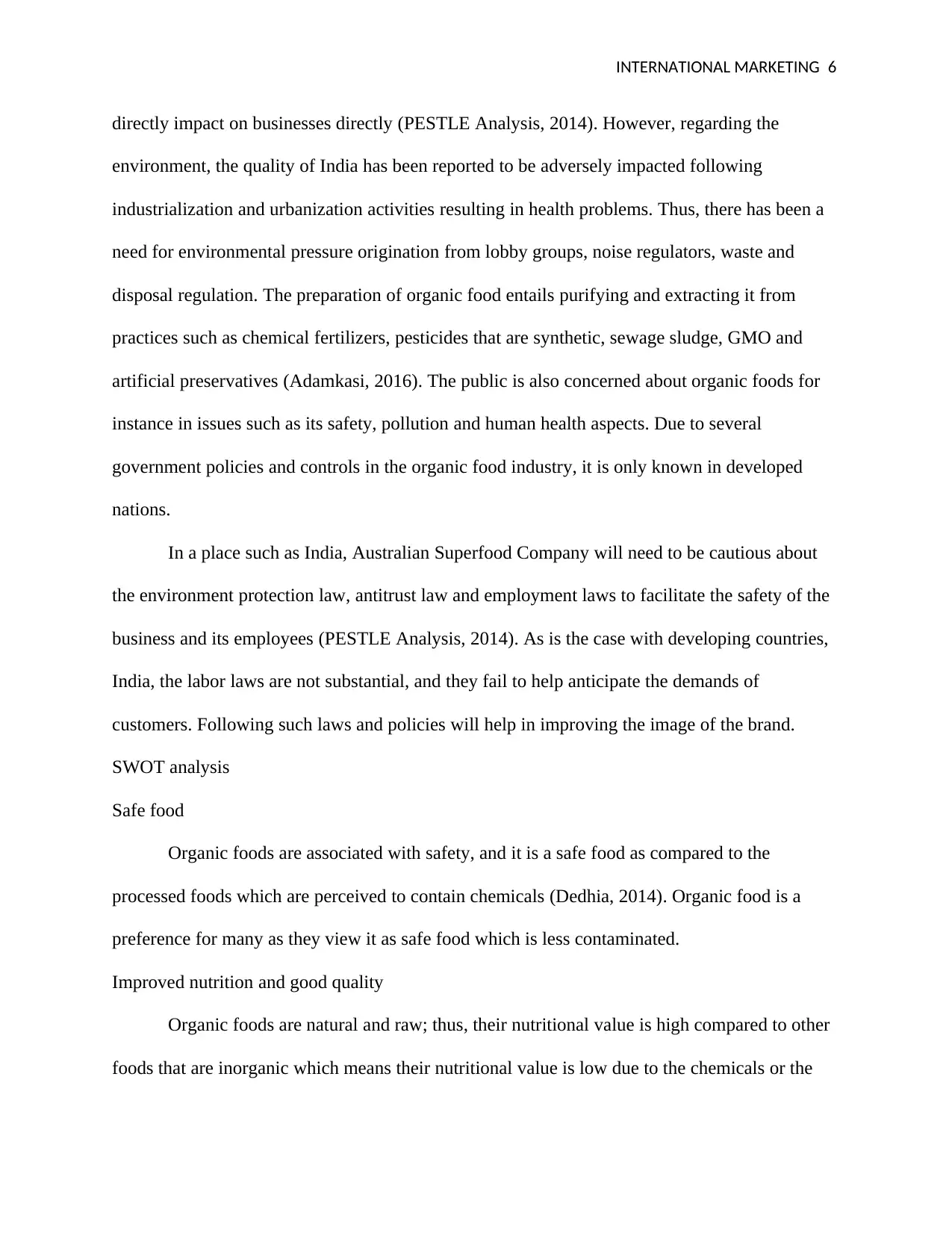
INTERNATIONAL MARKETING 6
directly impact on businesses directly (PESTLE Analysis, 2014). However, regarding the
environment, the quality of India has been reported to be adversely impacted following
industrialization and urbanization activities resulting in health problems. Thus, there has been a
need for environmental pressure origination from lobby groups, noise regulators, waste and
disposal regulation. The preparation of organic food entails purifying and extracting it from
practices such as chemical fertilizers, pesticides that are synthetic, sewage sludge, GMO and
artificial preservatives (Adamkasi, 2016). The public is also concerned about organic foods for
instance in issues such as its safety, pollution and human health aspects. Due to several
government policies and controls in the organic food industry, it is only known in developed
nations.
In a place such as India, Australian Superfood Company will need to be cautious about
the environment protection law, antitrust law and employment laws to facilitate the safety of the
business and its employees (PESTLE Analysis, 2014). As is the case with developing countries,
India, the labor laws are not substantial, and they fail to help anticipate the demands of
customers. Following such laws and policies will help in improving the image of the brand.
SWOT analysis
Safe food
Organic foods are associated with safety, and it is a safe food as compared to the
processed foods which are perceived to contain chemicals (Dedhia, 2014). Organic food is a
preference for many as they view it as safe food which is less contaminated.
Improved nutrition and good quality
Organic foods are natural and raw; thus, their nutritional value is high compared to other
foods that are inorganic which means their nutritional value is low due to the chemicals or the
directly impact on businesses directly (PESTLE Analysis, 2014). However, regarding the
environment, the quality of India has been reported to be adversely impacted following
industrialization and urbanization activities resulting in health problems. Thus, there has been a
need for environmental pressure origination from lobby groups, noise regulators, waste and
disposal regulation. The preparation of organic food entails purifying and extracting it from
practices such as chemical fertilizers, pesticides that are synthetic, sewage sludge, GMO and
artificial preservatives (Adamkasi, 2016). The public is also concerned about organic foods for
instance in issues such as its safety, pollution and human health aspects. Due to several
government policies and controls in the organic food industry, it is only known in developed
nations.
In a place such as India, Australian Superfood Company will need to be cautious about
the environment protection law, antitrust law and employment laws to facilitate the safety of the
business and its employees (PESTLE Analysis, 2014). As is the case with developing countries,
India, the labor laws are not substantial, and they fail to help anticipate the demands of
customers. Following such laws and policies will help in improving the image of the brand.
SWOT analysis
Safe food
Organic foods are associated with safety, and it is a safe food as compared to the
processed foods which are perceived to contain chemicals (Dedhia, 2014). Organic food is a
preference for many as they view it as safe food which is less contaminated.
Improved nutrition and good quality
Organic foods are natural and raw; thus, their nutritional value is high compared to other
foods that are inorganic which means their nutritional value is low due to the chemicals or the
⊘ This is a preview!⊘
Do you want full access?
Subscribe today to unlock all pages.

Trusted by 1+ million students worldwide
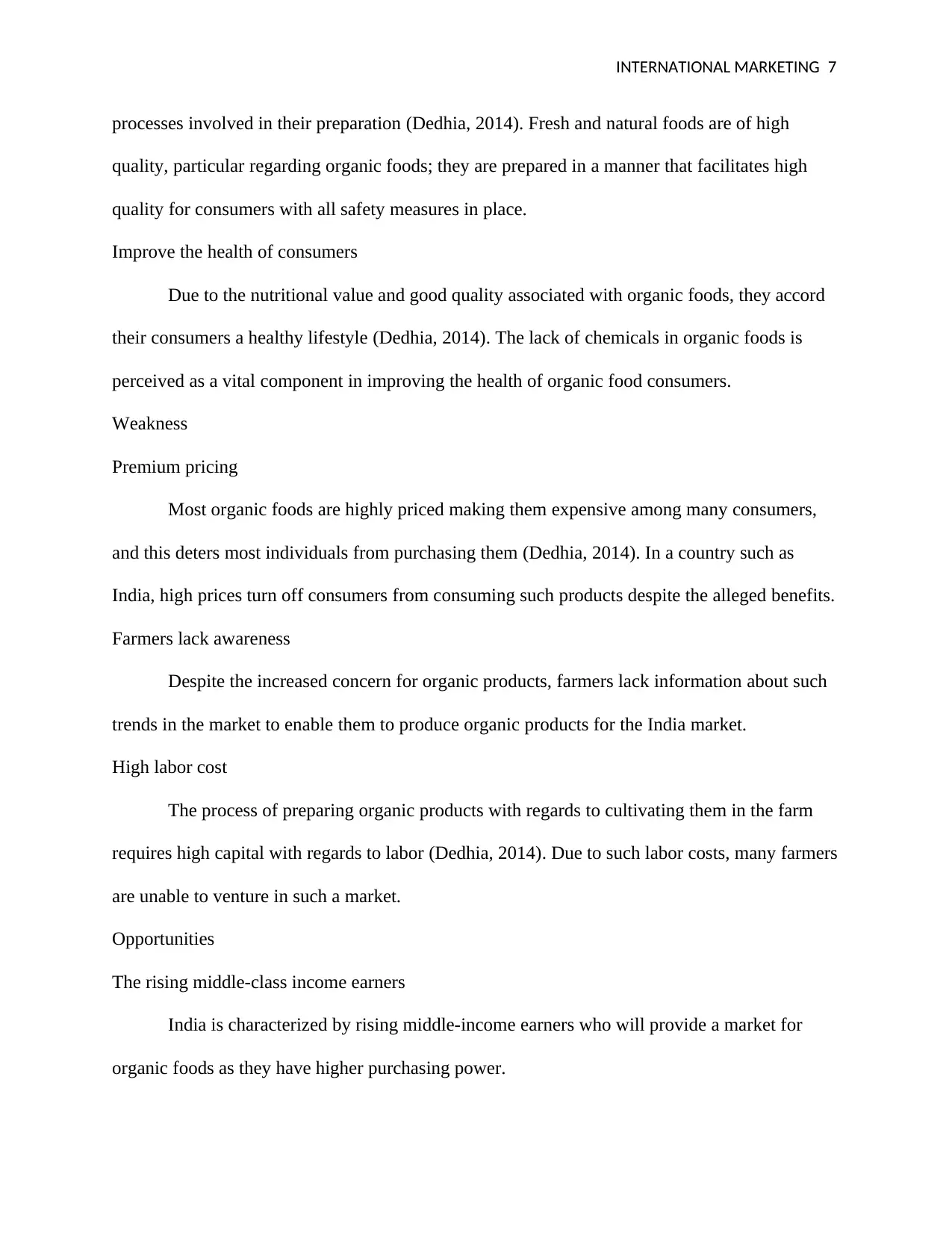
INTERNATIONAL MARKETING 7
processes involved in their preparation (Dedhia, 2014). Fresh and natural foods are of high
quality, particular regarding organic foods; they are prepared in a manner that facilitates high
quality for consumers with all safety measures in place.
Improve the health of consumers
Due to the nutritional value and good quality associated with organic foods, they accord
their consumers a healthy lifestyle (Dedhia, 2014). The lack of chemicals in organic foods is
perceived as a vital component in improving the health of organic food consumers.
Weakness
Premium pricing
Most organic foods are highly priced making them expensive among many consumers,
and this deters most individuals from purchasing them (Dedhia, 2014). In a country such as
India, high prices turn off consumers from consuming such products despite the alleged benefits.
Farmers lack awareness
Despite the increased concern for organic products, farmers lack information about such
trends in the market to enable them to produce organic products for the India market.
High labor cost
The process of preparing organic products with regards to cultivating them in the farm
requires high capital with regards to labor (Dedhia, 2014). Due to such labor costs, many farmers
are unable to venture in such a market.
Opportunities
The rising middle-class income earners
India is characterized by rising middle-income earners who will provide a market for
organic foods as they have higher purchasing power.
processes involved in their preparation (Dedhia, 2014). Fresh and natural foods are of high
quality, particular regarding organic foods; they are prepared in a manner that facilitates high
quality for consumers with all safety measures in place.
Improve the health of consumers
Due to the nutritional value and good quality associated with organic foods, they accord
their consumers a healthy lifestyle (Dedhia, 2014). The lack of chemicals in organic foods is
perceived as a vital component in improving the health of organic food consumers.
Weakness
Premium pricing
Most organic foods are highly priced making them expensive among many consumers,
and this deters most individuals from purchasing them (Dedhia, 2014). In a country such as
India, high prices turn off consumers from consuming such products despite the alleged benefits.
Farmers lack awareness
Despite the increased concern for organic products, farmers lack information about such
trends in the market to enable them to produce organic products for the India market.
High labor cost
The process of preparing organic products with regards to cultivating them in the farm
requires high capital with regards to labor (Dedhia, 2014). Due to such labor costs, many farmers
are unable to venture in such a market.
Opportunities
The rising middle-class income earners
India is characterized by rising middle-income earners who will provide a market for
organic foods as they have higher purchasing power.
Paraphrase This Document
Need a fresh take? Get an instant paraphrase of this document with our AI Paraphraser
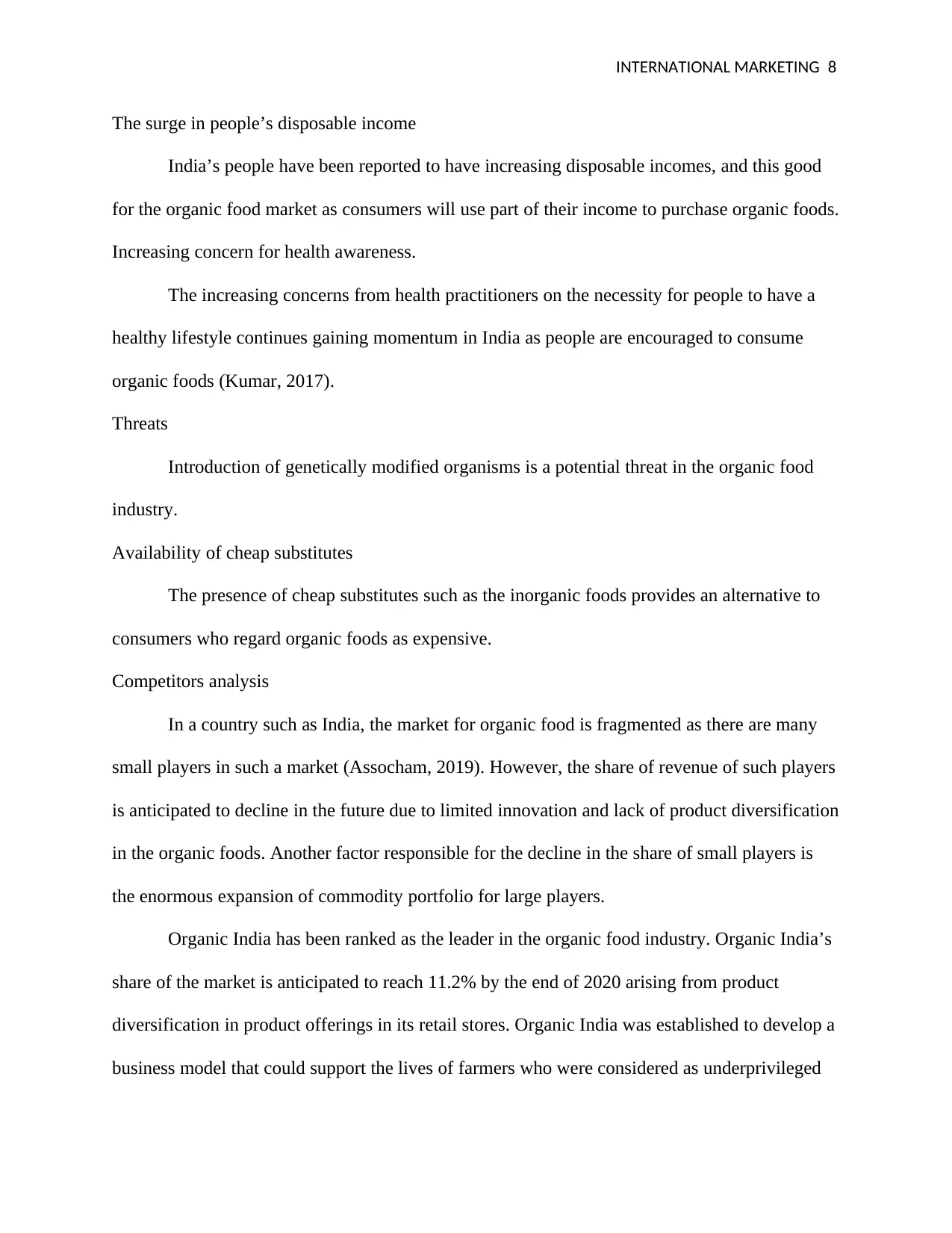
INTERNATIONAL MARKETING 8
The surge in people’s disposable income
India’s people have been reported to have increasing disposable incomes, and this good
for the organic food market as consumers will use part of their income to purchase organic foods.
Increasing concern for health awareness.
The increasing concerns from health practitioners on the necessity for people to have a
healthy lifestyle continues gaining momentum in India as people are encouraged to consume
organic foods (Kumar, 2017).
Threats
Introduction of genetically modified organisms is a potential threat in the organic food
industry.
Availability of cheap substitutes
The presence of cheap substitutes such as the inorganic foods provides an alternative to
consumers who regard organic foods as expensive.
Competitors analysis
In a country such as India, the market for organic food is fragmented as there are many
small players in such a market (Assocham, 2019). However, the share of revenue of such players
is anticipated to decline in the future due to limited innovation and lack of product diversification
in the organic foods. Another factor responsible for the decline in the share of small players is
the enormous expansion of commodity portfolio for large players.
Organic India has been ranked as the leader in the organic food industry. Organic India’s
share of the market is anticipated to reach 11.2% by the end of 2020 arising from product
diversification in product offerings in its retail stores. Organic India was established to develop a
business model that could support the lives of farmers who were considered as underprivileged
The surge in people’s disposable income
India’s people have been reported to have increasing disposable incomes, and this good
for the organic food market as consumers will use part of their income to purchase organic foods.
Increasing concern for health awareness.
The increasing concerns from health practitioners on the necessity for people to have a
healthy lifestyle continues gaining momentum in India as people are encouraged to consume
organic foods (Kumar, 2017).
Threats
Introduction of genetically modified organisms is a potential threat in the organic food
industry.
Availability of cheap substitutes
The presence of cheap substitutes such as the inorganic foods provides an alternative to
consumers who regard organic foods as expensive.
Competitors analysis
In a country such as India, the market for organic food is fragmented as there are many
small players in such a market (Assocham, 2019). However, the share of revenue of such players
is anticipated to decline in the future due to limited innovation and lack of product diversification
in the organic foods. Another factor responsible for the decline in the share of small players is
the enormous expansion of commodity portfolio for large players.
Organic India has been ranked as the leader in the organic food industry. Organic India’s
share of the market is anticipated to reach 11.2% by the end of 2020 arising from product
diversification in product offerings in its retail stores. Organic India was established to develop a
business model that could support the lives of farmers who were considered as underprivileged
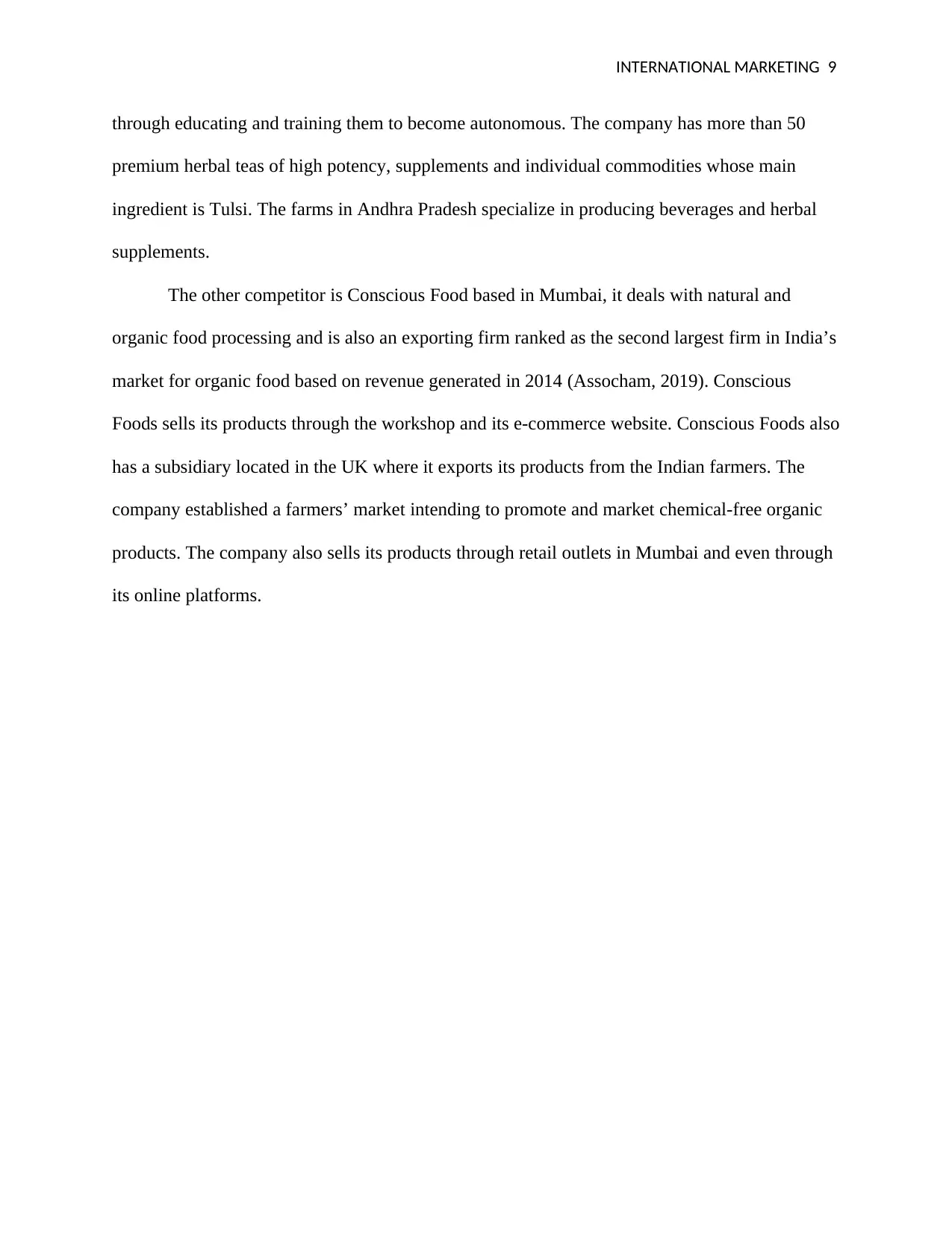
INTERNATIONAL MARKETING 9
through educating and training them to become autonomous. The company has more than 50
premium herbal teas of high potency, supplements and individual commodities whose main
ingredient is Tulsi. The farms in Andhra Pradesh specialize in producing beverages and herbal
supplements.
The other competitor is Conscious Food based in Mumbai, it deals with natural and
organic food processing and is also an exporting firm ranked as the second largest firm in India’s
market for organic food based on revenue generated in 2014 (Assocham, 2019). Conscious
Foods sells its products through the workshop and its e-commerce website. Conscious Foods also
has a subsidiary located in the UK where it exports its products from the Indian farmers. The
company established a farmers’ market intending to promote and market chemical-free organic
products. The company also sells its products through retail outlets in Mumbai and even through
its online platforms.
through educating and training them to become autonomous. The company has more than 50
premium herbal teas of high potency, supplements and individual commodities whose main
ingredient is Tulsi. The farms in Andhra Pradesh specialize in producing beverages and herbal
supplements.
The other competitor is Conscious Food based in Mumbai, it deals with natural and
organic food processing and is also an exporting firm ranked as the second largest firm in India’s
market for organic food based on revenue generated in 2014 (Assocham, 2019). Conscious
Foods sells its products through the workshop and its e-commerce website. Conscious Foods also
has a subsidiary located in the UK where it exports its products from the Indian farmers. The
company established a farmers’ market intending to promote and market chemical-free organic
products. The company also sells its products through retail outlets in Mumbai and even through
its online platforms.
⊘ This is a preview!⊘
Do you want full access?
Subscribe today to unlock all pages.

Trusted by 1+ million students worldwide
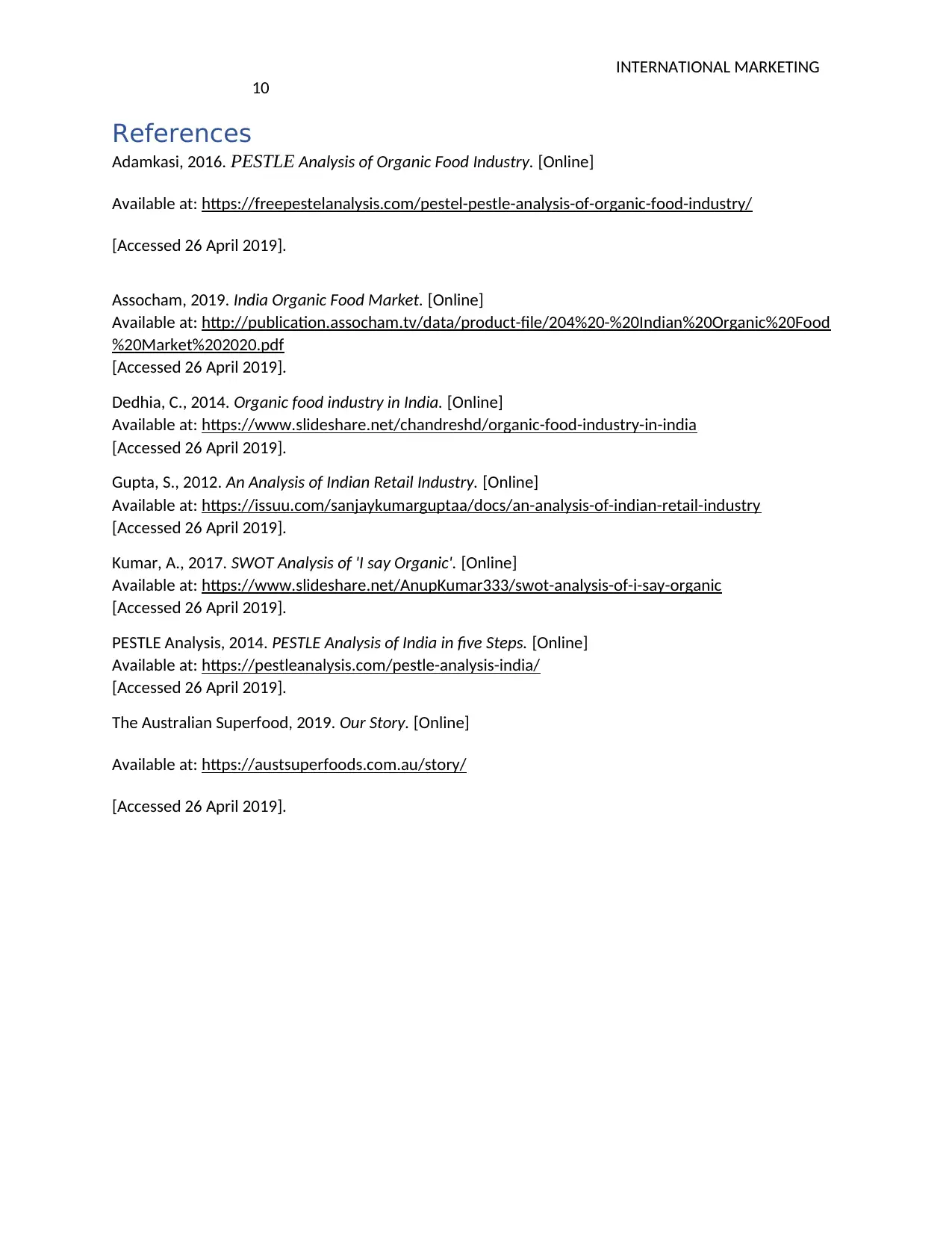
INTERNATIONAL MARKETING
10
References
Adamkasi, 2016. PESTLE Analysis of Organic Food Industry. [Online]
Available at: https://freepestelanalysis.com/pestel-pestle-analysis-of-organic-food-industry/
[Accessed 26 April 2019].
Assocham, 2019. India Organic Food Market. [Online]
Available at: http://publication.assocham.tv/data/product-file/204%20-%20Indian%20Organic%20Food
%20Market%202020.pdf
[Accessed 26 April 2019].
Dedhia, C., 2014. Organic food industry in India. [Online]
Available at: https://www.slideshare.net/chandreshd/organic-food-industry-in-india
[Accessed 26 April 2019].
Gupta, S., 2012. An Analysis of Indian Retail Industry. [Online]
Available at: https://issuu.com/sanjaykumarguptaa/docs/an-analysis-of-indian-retail-industry
[Accessed 26 April 2019].
Kumar, A., 2017. SWOT Analysis of 'I say Organic'. [Online]
Available at: https://www.slideshare.net/AnupKumar333/swot-analysis-of-i-say-organic
[Accessed 26 April 2019].
PESTLE Analysis, 2014. PESTLE Analysis of India in five Steps. [Online]
Available at: https://pestleanalysis.com/pestle-analysis-india/
[Accessed 26 April 2019].
The Australian Superfood, 2019. Our Story. [Online]
Available at: https://austsuperfoods.com.au/story/
[Accessed 26 April 2019].
10
References
Adamkasi, 2016. PESTLE Analysis of Organic Food Industry. [Online]
Available at: https://freepestelanalysis.com/pestel-pestle-analysis-of-organic-food-industry/
[Accessed 26 April 2019].
Assocham, 2019. India Organic Food Market. [Online]
Available at: http://publication.assocham.tv/data/product-file/204%20-%20Indian%20Organic%20Food
%20Market%202020.pdf
[Accessed 26 April 2019].
Dedhia, C., 2014. Organic food industry in India. [Online]
Available at: https://www.slideshare.net/chandreshd/organic-food-industry-in-india
[Accessed 26 April 2019].
Gupta, S., 2012. An Analysis of Indian Retail Industry. [Online]
Available at: https://issuu.com/sanjaykumarguptaa/docs/an-analysis-of-indian-retail-industry
[Accessed 26 April 2019].
Kumar, A., 2017. SWOT Analysis of 'I say Organic'. [Online]
Available at: https://www.slideshare.net/AnupKumar333/swot-analysis-of-i-say-organic
[Accessed 26 April 2019].
PESTLE Analysis, 2014. PESTLE Analysis of India in five Steps. [Online]
Available at: https://pestleanalysis.com/pestle-analysis-india/
[Accessed 26 April 2019].
The Australian Superfood, 2019. Our Story. [Online]
Available at: https://austsuperfoods.com.au/story/
[Accessed 26 April 2019].
1 out of 10
Related Documents
Your All-in-One AI-Powered Toolkit for Academic Success.
+13062052269
info@desklib.com
Available 24*7 on WhatsApp / Email
![[object Object]](/_next/static/media/star-bottom.7253800d.svg)
Unlock your academic potential
Copyright © 2020–2025 A2Z Services. All Rights Reserved. Developed and managed by ZUCOL.





